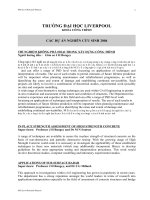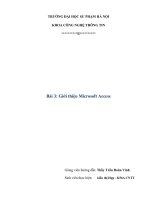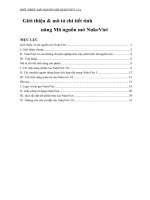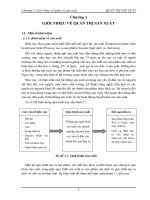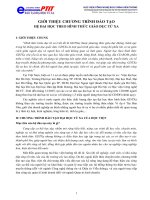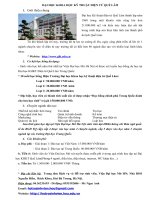Giới thiệu University of Liverpool
Bạn đang xem bản rút gọn của tài liệu. Xem và tải ngay bản đầy đủ của tài liệu tại đây (143.67 KB, 12 trang )
PhD Level Research Projects
TRƯỜNG ĐẠI HỌC LIVERPOOL
KHOA CÔNG TRÌNH
CÁC DỰ ÁN NGHIÊN CỨU SINH 2004
THÍ NGHIỆM KHÔNG PHÁ HOẠI TRONG XÂY DỰNG CÔNG TRÌNH
Người hướng dẫn : Giáo sư J H Bungey
Công ngh ệ th í nghi ệm kh ông ph á ho ại k ết c ấu đ ư ợc s ử d ụng trong x ây d ựng c ông tr ình cho ph ép x ác
đ ịnh ch ính x ác b ản ch ất v à đi ều ki ện l àm vi ệc c ủa c ác k ết c ấu. Khoa c ó r ất nhi ều king nghi ệm v à th ực ti
ễn v ề l ĩnh v ực n ày v à c ó th ể h ư ớng d ẫn NCS v ề c ông ngh ệ v à gi ải th ích roc k ết qu ả.
and can offer a range of PhD level work focussing on applications of techniques and
interpretation of results. The use of such results to permit estimates of future lifetime prediction
will be important when planning maintenance and refurbishment programmes, as well as
identifying the cause and extent of damage and establishing continued serviceability. Such
projects are likely to involve a combination of theoretical studies, experimental work (possibly on
site) and computer modelling.
A wide range of non-destructive testing techniques are used within Civil Engineering to permit
in-situ evaluation and assessment of the nature and condition of structures. The Department has
extensive experience and expertise in this field and can offer a range of PhD level work focussing
on applications of techniques and interpretation of results. The use of such results to permit
estimates of future lifetime prediction will be important when planning maintenance and
refurbishment programmes, as well as identifying the cause and extent of damage and establishing
continued serviceability. M ỗi d ự án th ư ờng bao g ồm s ự k ết h ợp gi ữa nghi ên c ứu l ý thuy ết, c ác c ông t
ác th í nghi ệm th ực t ế (c ó th ể ở c ông tr ư ờng) v à m ô h ình m áy t ính
IN-PLACE STRENGTH ASSESSMENT OF HIGH STRENGTH CONCRETE
Supervisors: Professor J H Bungey and Dr M N Soutsos
A range of techniques are available to assess the in-place strength of structural concrete on the
basis of non-destructive and partially destructive testing. With the growing usage of High
Strength Concrete world-wide it is necessary to investigate the applicability of these established
techniques to these new materials (which may additionally incorporate fibres). to develop
guidelines for the most appropriate testing and interpretation procedures. This work would
involve theoretical studies, computer modelling and laboratory experimental studies.
APPLICATIONS OF SUB-SURFACE RADAR
Supervisors: Professor J H Bungey, and Dr S G Millard.
This approach to investigations within civil engineering has grown in popularity in recent years.
The department has a strong reputation amongst the world leaders in terms of research into
applications/interpretation especially in the field of assessment of concrete structures and bridge
scour problems. Current activities involve the use of neural networks and numerical modelling to
assist interpretation, and there is considerable scope for further projects in this area.
PhD Level Research Projects
1
PhD Level Research Projects
HIGH PERFORMANCE CONCRETE AND PRECAST CONCRETE PRODUCTS
MADE WITH RECYCLED DEMOLITION RUBBLE.
Supervisor: Dr M N Soutsos
For environmental and other reasons the number of readily accessible disposal sites around major
cities in the world have decreased in recent years. Both disposal volume and maximum sizes of
wastes have been restricted. The UK Government has taken a proactive stance on this issue and
has indicated that as much as 25% of construction aggregate demand should, in future be met
from secondary and recycled sources. Large-scale recycling of demolished concrete will
contribute not only to the solution of a growing waste disposal problem but will also help to
conserve natural resources of sand and gravel and to secure future supply of reasonably priced
aggregates for building and road construction purposes within large urban areas. It is the purpose
of this research project to examine current concerns with recycled aggregates and to promote their
safe and economical use in high performance concrete and precast concrete products. This work
would involve theoretical studies, computer modelling and laboratory experimental studies.
FAST TRACK CONSTRUCTION WITH POZZOLANIC MATERIALS SUCH AS
GROUND GRANULATED BLAST FURNACE SLAG AND PULVERISED FUEL ASH .
Supervisor: Dr M N Soutsos
The use of ground granulated blast furnace slag (ggbs) and pulverised fuel ash (pfa) and ternary
systems with condensed silica fume (csf) in concrete although economic has not gained popularity
in fast track construction because of the slower strength gain of these mixes at standard curing
temperatures. There are however indications that ggbs and pfa are heavily penalised by the
standard curing regimes. The high early age temperatures occurring inside structural elements
appear to provide the activation energy needed for the pozzolanic reaction to "kick-in" earlier.
This results in in-situ/air-cured or standard cured strength ratios of 2.0 to 2.4 as compared to ratios
of 1.0 to 1.4 for ordinary Portland cement concrete mixes. The main aim of this project will be to
investigate the early age strength development of ggbs, pfa, ggbs/csf and pfa/csf composite
cements under simulated in-situ temperature histories in order to give guidance for their use in
fast track construction. It is important that techniques for monitoring the strength development on
site, e.g., pull-out tests, microcores and maturity measurements, are validated for these composite
cements. This work would involve theoretical studies, computer modelling and laboratory
experimental studies
THERMAL STRESSES IN CONCRETE AT EARLY AGES.
Supervisor: Dr M N Soutsos
Thermal cracking in the structural concrete of foundations, bridges, tunnel linings and other
medium-sized elements has become an increasing problem in the past decades. Previous methods
of predicting thermal cracking and stresses in concrete structures have until now relied entirely on
empirical knowledge of previous construction. Now, with the advent of powerful computer
processing capabilities, it is proposed that a more rigorous and theoretically valid approach needs
to be adopted. Equipment will be developed together with practical experimental procedures for
determining the heat of hydration and early age mechanical properties of concrete specimens
undergoing the same temperature cycles as they would in a real structure. These will comprise the
increasing compressive and tensile strength, the increase of stiffness and the decrease of
relaxation capacity, the coefficient of thermal expansion and the influence of chemical reactions
on the deformation. These properties can then be used in conjunction with numerical modelling
techniques to look at the many ramifications of the heat problem. This will include the effects of
concrete strength, i.e. normal and high, binder type and content, size of structural element, casting
PhD Level Research Projects
2
PhD Level Research Projects
and ambient temperatures, formwork type and time of removal on the maximum temperature rise
and magnitude of the thermal stresses.
ASSESSMENT OF STEEL REINFORCEMENT CORROSION IN STRUCTURAL
CONCRETE
Supervisor: Dr S G Millard
The corrosion of reinforcement in steel reinforced concrete structures represents one of the major
problems challenging the civil engineering industry with a greater expenditure in the UK on
repair and refurbishment of old structures than on construction of new ones. An effective and
efficient means of assessing the location and the rate of reinforcement corrosion is required. The
PhD student will gain familiarisation with the electrochemical methods available of assessing the
rate of reinforcement corrosion and will seek to develop new techniques and methodology
suitable for a rapid on-site assessment of the magnitude of existing corrosion problems.
MIX DESIGN AND MECHANICAL PROPERTIES OF HIGH STRENGTH CONCRETE
PRODUCED IN THE UK.
Supervisor: Dr M N Soutsos
Concretes with compressive strengths up to 150N/mm
2
now being investigated in laboratories
have been the culmination of over 30 years of research within the UK. A real attempt to use the
material for anything other than academic research will also have to be a gradual process. The
first step will be to convince consultants and contractors that higher strengths than are currently
being used locally are advantageous and higher strength concretes are readily available and can
be produced economically. In this project, it is therefore proposed to carry out a national survey to
determine the highest concrete strengths that can be produced on a regional basis. These strengths
will depend on the regionally available aggregates and ready mixed concrete batching plant
facilities. If these strengths are to be produced easily and economically then the ready mixed
concrete suppliers will need guidelines for the optimisation of the concrete mix proportions for
these high strengths. In addition the consulting engineering firms will need to be able to predict
the properties of these concretes, e.g., moduli of elasticity and rupture and tensile splitting
strength, from relationships with compressive strength. This project will aim to provide such
information.
MIX DESIGN, MECHANICAL PROPERTIES AND IMPACT RESISTANCE OF
REACTIVE POWDER CONCRETE (RPC).
Supervisor: Dr M N Soutsos, Prof. J. H. Bungey and Dr. S G Millard
Ultra high performance fibre reinforced concretes (UHPFRCs) which have been developed in an
attempt to improve the mechanical performance of cementitious materials, especially strength and
ductility under tension. Typical composition of UHPFRC is as follows: A very low water-
cementitious ratio ranging from 0.16 to 0.24 achieved by using high cement content (955kg/m
3
)
and a high silica fume content (240kg/m
3
) and a high dosage of a superplasticiser (15 litres/m
3
).
The only “aggregate” used is fine (150-400 µm) quartz sand (1050kg/m
3
). A high percentage by
volume (2.5 to 10%) of special types of steel fibres (24 or 12 mm length and 0.16mm in diameter)
are used. The compressive strengths of Reactive Powder Concrete, one type of UHPFRC, are
likely to be between 170 to 230 MPa depending on the post-set heat treatment (20 to 90
0
C).
Values for flexural strengths are likely to be between 30 and 60 MPa, fracture energies between
20,000 and 40,000 J.m
-2
and moduli of elasticity between 50 to 60 GPa. RPC appears to be a
promising new material not only because of its enhanced ductility but also because the mixing
and casting procedures are no different to existing procedures for normal and high strength
concretes.
PhD Level Research Projects
3
PhD Level Research Projects
The project will aim to supplement and develop existing expertise and data available to the
supervisors to permit reliable estimation of the behaviour of RPC under impact and explosion
loading conditions. This will make use of state-of-the-art equipment, computer modelling
techniques and software. Specific objectives include:
• Determine guidelines for the production (selection of materials and mix proportions, and
curing regimes) of RPCs,
• Experimentally determine the mechanical properties, compressive and flexural strengths,
fracture energies, moduli of elasticity, of RPC to provide accurate input data for the computer
programs.
• Numerically and experimentally investigate the impact load resistance of RPC, with different
reinforcement details.
• Develop guidelines for the design and detailing of RPC elements to resist impact and
explosion loads.
• Develop computer simulation programs that will be able to provide accurate predictions of the
behaviour of RPC under impact and explosion loading.
Success of these objectives can be measured by the ability to develop a library of typical
behaviour of RPC under impact and explosion loading situations which will encompass a range of
mix compositions, size of structural element, as well as reinforcement detailing, for direct
comparison with laboratory models.
FORENSIC AND CONSERVATION ENGINEERING
Supervisor: Mr K G Smith
The study of why things fail invites research into new practices. These techniques have
applications in the conservation of our oldest and most famous structures. It is of commercial,
cultural and scientific importance, especially in a cultural centre like Liverpool. A multi-
disciplinary approach is possible with a specialisation in appropriate aspects. For example these
could range from structural analysis to construction history. Current interests include:
• Stability of listed facades during alterations.
• Computer induced failures.
• Studies of historical failures and the development of design philosophies.
There would be scope for interaction with consulting engineers, government agencies and other
universities. Applications are encouraged from people wishing to study part-time and those whose
first degree is not in civil engineering.
PhD Level Research Projects
4
PhD Level Research Projects
MANAGEMENT STUDIES.
Supervisor: Mr K G Smith
From the relatively new discipline of Facilities Management, to conventional project
management, this wide area offers scope for reassessment and improvement of practice. It is
particularly suitable for mature students with some experience, not necessarily in engineering, and
wishing to study part time. Current interests include:
• Influence of computers on globalisation of trading practice.
• Quality systems take-up in developing economies.
• Decision tools for strategic Facilities Management.
Some topics may suit overseas students wishing to efficiently transfer best practice by using a
combination of analytical and case study approaches in their own country.
GEOTECHNICAL ENGINEERING
Supervisor: Dr. E A Dickin
Physical modelling of problems in geotechnical engineering can be greatly improved by
conducting tests on relatively small models in a centrifuge. The models are thereby subjected to
the stress levels anticipated by their full-scale prototypes and hence scaling errors are largely
overcome. The approach has considerable advantages over full scale testing, which is both time
consuming and expensive. While the centrifuge testing technique is now well established
worldwide, very few Civil Engineering Departments in the UK possess such a facility. The
machine at the University of Liverpool has formed the cornerstone of the experimental research in
geotechnics. In general this experimental approach has been carried out in parallel with finite
element modelling work using hyperbolic stress/strain models to represent the soil and
structure/soil interface. Numerous studies investigating the interaction between soil and retaining
or buried structures have been conducted using this philosophy. These include the behaviour of
piles and pile groups, cantilever and anchor walls, the uplift behaviour of plate anchors, under-
reamed piles and pipelines, the moment-carrying capacity of pier foundations and the stability of
transmission tower foundations.
Studies currently in progress involve:
• The enhancement of the anchoring capacity of a spread foundation by means of geogrid
reinforcement;
• The bearing capacity of shallow foundations subject to inclined and eccentric loading;
• The uplift behaviour of pyramid-shaped transmission tower foundations experiencing
inundation;
• The moment–carrying capacity of railway gantry and mast foundations;
• The influence of soil deposits on the seismic hazard.
STRUCTURAL INTERACTION DURING EARTHQUAKES
Supervisors: Mr C. Thomas
The theoretical modelling of the dynamic behaviour of structures and also the ground during a
seismic event is possible using the finite element technique. Although both aspects have been
studied in considerable detail the interaction between a structure, ground properties and adjacent
structures has not been fully researched. The recent introduction of non-linear elements into the
PhD Level Research Projects
5

